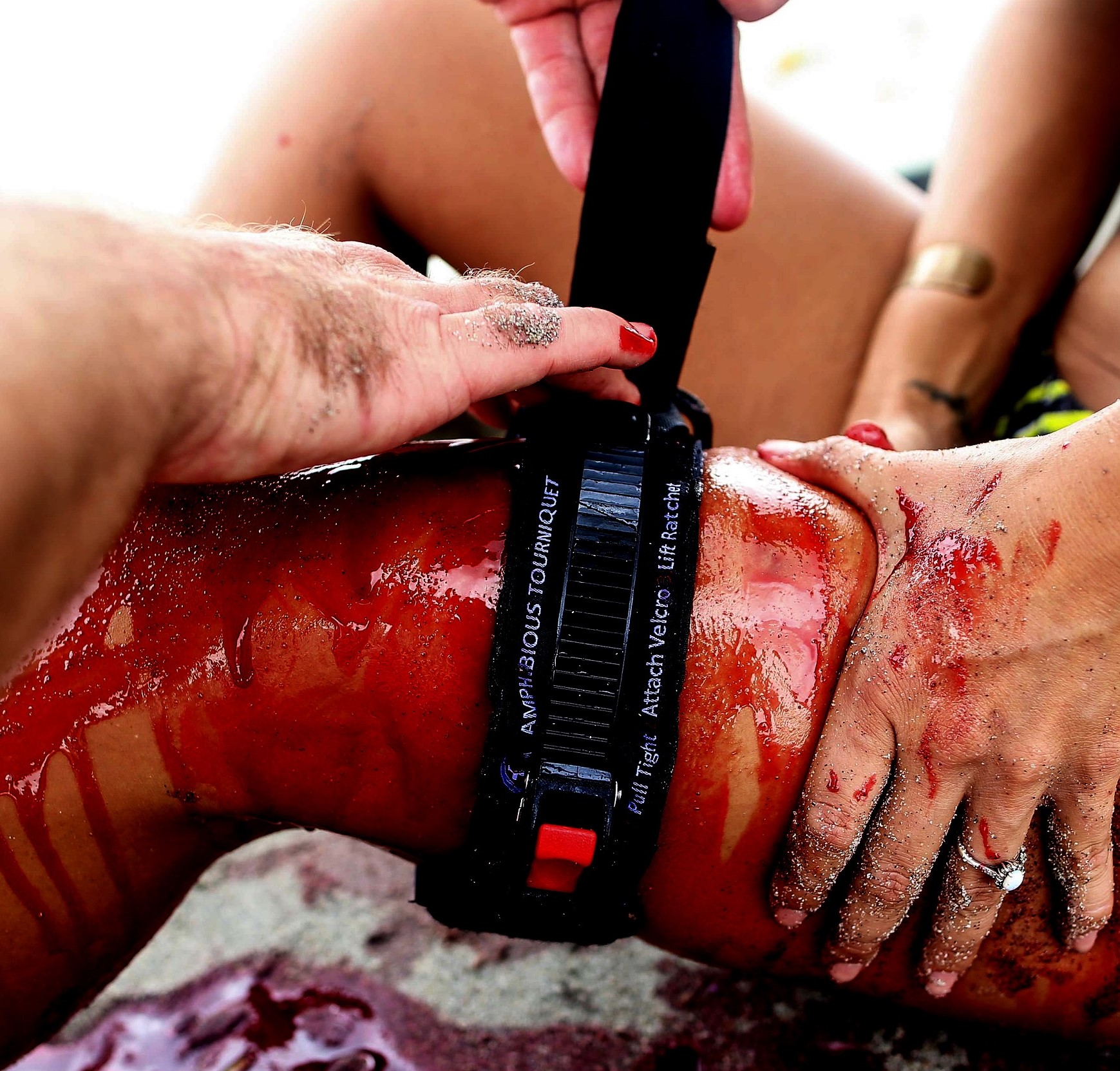Prehospital Damage Control: The Management of Volume, Temperature…and Bleeding!
Abstract
Damage control resuscitation should be initiated as soon as possible after a traumatic event to avoid metabolic decompensation and high mortality rates. This article aims to assess the position of the Trauma and Emergency Surgery Group (CTE) from Cali, Colombia regarding prehospital care, and to present our experience in the implementation of the “Stop the Bleed” initiative within Latin America.
Prehospital care is phase 0 of damage control resuscitation. Prehospital damage control must follow the guidelines proposed by the “Stop the Bleed” initiative. We identified that prehospital personnel has a better perception of hemostatic techniques such as tourniquet use than hospital providers. The use of tourniquets is recommended as a measure to control bleeding. Fluid management should be initiated using low volume crystalloids, ideally, 250cc boluses, maintaining the principle of permissive hypotension with a systolic blood pressure range between 80- and 90-mm Hg. Hypothermia must be managed using warmed blankets or the administration of intravenous fluids warmed before infusion. However, these prehospital measures should not delay the transfer time of a patient from the scene to the hospital.
To conclude, prehospital damage control measures are the first steps in the control of bleeding and the initiation of hemostatic resuscitation in the traumatically injured patient. Early interventions without increasing the transfer time to a hospital are the keys to increase the survival rate of severe trauma patients.
Authors
Downloads
Keywords
- Trauma
- prehospital care
- damage control
- hemorrhage
- Exsanguination
- Shock, Hemorrhagic
- Tourniquets
- Hypothermia
- Crystalloid Solutions
- Hemostatic Techniques
- Blood Volume
- Emergency Medical Services
- Compartment Syndromes
- Reperfusion
References
Kauvar DS, Lefering R, Wade CE. Impact of hemorrhage on trauma outcome: an overview of epidemiology, clinical presentations, and therapeutic considerations. J Trauma 2006;60:S3-11. https://doi.org/10.1097/01.ta.0000199961.02677.19.
Cothren CC, Moore EE, Hedegaard HB, Meng K. Epidemiology of urban trauma deaths: A comprehensive reassessment 10 years later. World J Surg 2007;31:1507-11. https://doi.org/10.1007/s00268-007-9087-2.
Acosta MD, José A, Yang MD, Jack C, Winchell MD, Robert J, et al. Lethal injuries and time to death in a level I trauma center. J Am Coll Surg 1998;186:528-33. https://doi.org/10.1016/S1072-7515(98)00082-9
Cannon JW. Prehospital damage-control resuscitation. N Engl J Med 2018;379:387-8. https://doi.org/10.1056/NEJMe1805705.
Rotondo MF, Zonies DH. The damage control sequence and underlying logic. Surg Clin North Am 1997;77:761-77. https://doi.org/10.1016/S0039-6109(05)70582-X
Johnson JW, Gracias VH, Schwab CW, Reilly PM, Kauder DR, Shapiro MB, et al. Evolution in damage control for exsanguinating penetrating abdominal injury. J Trauma 2001;51:261-71. https://doi.org/10.1097/00005373-200108000-00007.
Kalkwarf KJ, Cotton BA. Resuscitation for Hypovolemic Shock. Surg Clin North Am 2017;97:1307-21. https://doi.org/10.1016/j.suc.2017.07.011.
Kaafarani HMA, Velmahos GC. Damage control resuscitation in trauma. Scand J Surg 2014;103:81-8. https://doi.org/10.1177/1457496914524388.
Van PY, Holcomb JB, Schreiber MA. Novel concepts for damage control resuscitation in trauma. Curr Opin Crit Care 2017;23:498-502. https://doi.org/10.1097/MCC.0000000000000455.
Lendrum R, Perkins Z, Chana M, Marsden M, Davenport R, Grier G, et al. Pre-hospital Resuscitative Endovascular Balloon Occlusion of the Aorta (REBOA) for exsanguinating pelvic haemorrhage. Resuscitation 2019;135:6-13. https://doi.org/10.1016/j.resuscitation.2018.12.018.
Mathers C, Stevens G, Hogan D, Mahanani WR, Ho J. Global and Regional Causes of Death: Patterns and Trends, 2000-15. Dis. Control Priorities, Third Ed. (Volume 9) Improv. Heal. Reducing Poverty, The World Bank; 2017, p. 69-104. https://doi.org/10.1596/978-1-4648-0527-1_ch4.
DANE. Defunciones no fetales 2019.
Ordoñez CA, Manzano-Nunez R, Naranjo MP, Foianini E, Cevallos C, Londoño MA, et al. Casualties of peace: An analysis of casualties admitted to the intensive care unit during the negotiation of the comprehensive Colombian process of peace. World J Emerg Surg 2018;13. https://doi.org/10.1186/s13017-017-0161-2.
Kalkwarf KJ, Drake SA, Yang Y, Thetford C, Myers L, Brock M, et al. Bleeding to Death in a Big City: An Analysis of All Trauma Deaths From Hemorrhage in a Metropolitan Area Over One Year. J Trauma Acute Care Surg 2020. https://doi.org/10.1097/TA.0000000000002833.
Moore EE. Staged laparotomy for the hypothermia, acidosis, and coagulopathy syndrome. Am J Surg 1996;172:405-10. https://doi.org/10.1016/S0002-9610(96)00216-4.
Ditzel RM, Anderson JL, Eisenhart WJ, Rankin CJ, DeFeo DR, Oak S, et al. A review of transfusion- And trauma-induced hypocalcemia: Is it time to change the lethal triad to the lethal diamond? J Trauma Acute Care Surg 2020;88:434-9. https://doi.org/10.1097/TA.0000000000002570.
Mitra B, Tullio F, Cameron PA, Fitzgerald M. Trauma patients with the "triad of death." Emerg Med J 2012;29:622-5. https://doi.org/10.1136/emj.2011.113167.
Martini WZ, Pusateri AE, Uscilowicz JM, Delgado A V., Holcomb JB, Tyburski JG, et al. Independent contributions of hypothermia and acidosis to coagulopathy in swine. J Trauma - Inj Infect Crit Care 2005;58:1002-10. https://doi.org/10.1097/01.TA.0000156246.53383.9F.
Wolberg AS, Meng ZH, Monroe DM, Hoffman M. A systematic evaluation of the effect of temperature on coagulation enzyme activity and platelet function. J Trauma - Inj Infect Crit Care 2004;56:1221-8. https://doi.org/10.1097/01.TA.0000064328.97941.FC.
Cohen MJ, Kutcher M, Redick B, Nelson M, Call M, Knudson M, et al. Clinical and mechanistic drivers of acute traumatic coagulopathy. J Trauma Acute Care Surg 2013;75:40-7. https://doi.org/10.1097/TA.0b013e31828fa43d.
Brohi K, Singh J, Heron M, Coats T. Acute Traumatic Coagulopathy. J Trauma 2003;54:1127-30. https://doi.org/10.1097/01.TA.0000069184.82147.06.
Harris T, Davenport R, Mak M, Brohi K. The Evolving Science of Trauma Resuscitation. Emerg Med Clin North Am 2018;36:85-106. https://doi.org/10.1016/j.emc.2017.08.009.
Keel M, Trentz O. Pathophysiology of polytrauma. Injury 2005;36:691-709. https://doi.org/10.1016/j.injury.2004.12.037.
Keel M, Labler L, Trentz O. "Damage control" in severely injured patients: Why, when, and how? Eur J Trauma 2005;31:212-21. https://doi.org/10.1007/s00068-005-2034-8.
Teuben M, Löhr N, Jensen KO, Brüesch M, Müller S, Pfeifer R, et al. Improved pre-hospital care efficiency due to the implementation of pre-hospital trauma life support (PHTLS ® ) algorithms. Eur J Trauma Emerg Surg 2019. https://doi.org/10.1007/s00068-019-01141-1.
Goolsby C, Jacobs L, Hunt RC, Goralnick E, Singletary EM, Levy MJ, et al. Stop the Bleed Education Consortium: Education program content and delivery recommendations. J Trauma Acute Care Surg 2018;84:205-10. https://doi.org/10.1097/TA.0000000000001732.
Wo CCJ, Shoemaker WC, Appel PL, Bishop MH, Kram HB, Hardin E. Unreliability of blood pressure and heart rate to evaluate cardiac output in emergency resuscitation and critical illness. Crit Care Med 1993;21:218-23. https://doi.org/10.1097/00003246-199302000-00012.
Mutschler M, Nienaber U, Brockamp T, Wafaisade A, Wyen H, Peiniger S, et al. A critical reappraisal of the ATLS classification of hypovolaemic shock: Does it really reflect clinical reality? Resuscitation 2013;84:309-13. https://doi.org/10.1016/j.resuscitation.2012.07.012.
Crerar‐Gilbert A. Advanced trauma life support. vol. 48. 2018. https://doi.org/10.1111/j.1365-2044.1993.tb07025.x.
Dutton RP. Haemostatic resuscitation. Br J Anaesth 2012;109:39-46. https://doi.org/10.1093/bja/aes389.
Moore K. Stop the Bleeding: The Hartford Consensus. J Emerg Nurs 2017;43:482-3. https://doi.org/10.1016/j.jen.2017.06.009.
Singletary EM, Charlton NP, Epstein JL, Ferguson JD, Jensen JL, MacPherson AI, et al. Part 15: First aid: 2015 American Heart Association and American red cross guidelines update for first aid. Circulation 2015;132:S574-89. https://doi.org/10.1161/CIR.0000000000000269.
Zideman DA, De Buck EDJ, Singletary EM, Cassan P, Chalkias AF, Evans TR, et al. European Resuscitation Council Guidelines for Resuscitation 2015 Section 9. First aid. Resuscitation 2015;95:278-87. https://doi.org/10.1016/j.resuscitation.2015.07.031.
Recinos G, Inaba K. Local and systemic hemostatics in trauma : a review Travmada lokal ve sistemik hemostatik ajanlar : Derleme yaz › s ›. Turkish J Trauma Emerg Surg 2008;14:175-81.
Hsu YT, Chang DC, Perez NP, Westfal ML, Kelleher CM, Sacks CA, et al. Civilian firearm-related injuries: How often is a tourniquet beneficial? Ann Surg 2020;271:E12-3. https://doi.org/10.1097/SLA.0000000000003622.
Teixeira PGR, Brown CVR, Emigh B, Long M, Foreman M, Eastridge B, et al. Civilian Prehospital Tourniquet Use Is Associated with Improved Survival in Patients with Peripheral Vascular Injury. J Am Coll Surg 2018;226:769-776.e1. https://doi.org/10.1016/j.jamcollsurg.2018.01.047.
Inaba K, Siboni S, Resnick S, Zhu J, Wong MD, Haltmeier T, et al. Tourniquet use for civilian extremity trauma. J Trauma Acute Care Surg 2015;79:232-7. https://doi.org/10.1097/TA.0000000000000747.
Goralnick E, Chaudhary MA, McCarty JC, Caterson EJ, Goldberg SA, Herrera-Escobar JP, et al. Effectiveness of instructional interventions for hemorrhage control readiness for laypersons in the public access and tourniquet training study (PATTS) a randomized clinical trial. JAMA Surg 2018;153:791-9. https://doi.org/10.1001/jamasurg.2018.1099.
Galante JM. Using tourniquets to stop bleeding. JAMA - J Am Med Assoc 2017;317:1490. https://doi.org/10.1001/jama.2015.8581.
Orlas CP, Parra MW, Herrera-Escobar JP, Meléndez JJ, Serna JJ, Angamarca E, et al. The Challenge of Implementing the "Stop the Bleed" Campaign in Latin America. J Surg Res 2020;246:591-8. https://doi.org/10.1016/j.jss.2019.09.042.
Orlas CP, Manzano-Núñez R, Pablo Herrera J, García AF, Chica J, Salazar CJ, et al. Control prehospitalario de la hemorragia en pacientes de trauma: una estrategia de prevención secundaria factible para países de bajos y medianos ingresos. Rev Colomb Cirugía 2018;33:371-9. https://doi.org/10.30944/20117582.84.
Cannon E. Nature and treatment of wound shock and allied conditions. JAMA 1918;70:520. https://doi.org/10.1001/jama.1918.02600080022008.
Bickell WH, Wall MJ, Pepe PE, Martin RR, Ginger VF, Allen MK, et al. Immediate versus Delayed Fluid Resuscitation for Hypotensive Patients with Penetrating Torso Injuries. N Engl J Med 1994;331:1105-9. https://doi.org/10.1056/NEJM199410273311701.
Dutton R, Mackenzie C, Scalea T. Hypotensive resuscitation during active hemorrhage: impact on in-hospital mortality. J Trauma 2002;52:1141-6. https://doi.org/10.1097/00005373-200206000-00020
Qureshi SH, Rizvi SI, Patel NN, Murphy GJ. Meta-analysis of colloids versus crystalloids in critically ill, trauma and surgical patients. Br J Surg 2016;103:14-26. https://doi.org/10.1002/bjs.9943.
Perel P, Roberts I, Ker K. Colloids versus crystalloids for fluid resuscitation in critically ill patients. Cochrane Database Syst Rev 2013. https://doi.org/10.1002/14651858.CD000567.pub6.
Bulger EM, May S, Kerby JD, Emerson S, Stiell IG, Schreiber MA, et al. Out-of-hospital hypertonic resuscitation after traumatic hypovolemic shock: A randomized, placebo controlled trial. Ann Surg 2011;253:431-41. https://doi.org/10.1097/SLA.0b013e3181fcdb22.
Delano MJ, Rizoli SB, Rhind SG, Cuschieri J, Junger W, Baker AJ, et al. Prehospital resuscitation of traumatic hemorrhagic shock with hypertonic solutions worsens hypocoagulation and hyperfibrinolysis. Shock 2015;44:25-31. https://doi.org/10.1097/SHK.0000000000000368.
Bilotta F, Rosa G. Saline or albumin for fluid resuscitation in traumatic brain injury [6]. N Engl J Med 2007;357:2635. https://doi.org/10.1056/nejmc072827.
Boer C, Bossers SM, Koning NJ. Choice of fluid type: physiological concepts and perioperative indications. Br J Anaesth 2018;120:384-96. https://doi.org/10.1016/j.bja.2017.10.022.
Santry HP, Alam HB. Fluid resuscitation: Past, present, and the future. Shock 2010;33:229-41. https://doi.org/10.1097/SHK.0b013e3181c30f0c.
Murad MK, Issa DB, Mustafa FM, Hassan HO, Husum H. Prehospital trauma system reduces mortality in severe trauma: A controlled study of road traffic casualties in Iraq. Prehosp Disaster Med 2012;27:36-41. https://doi.org/10.1017/S1049023X11006819.
Albreiki M, Voegeli D. Permissive hypotensive resuscitation in adult patients with traumatic haemorrhagic shock: a systematic review. Eur J Trauma Emerg Surg 2018;44:191-202. https://doi.org/10.1007/s00068-017-0862-y.
Tremblay LN, Rizoli SB, Brenneman FD. Advances in fluid resuscitation of hemorrhagic shock. Can J Surg 2001;44:172-9.
Ramesh GH, Uma JC, Farhath S. Fluid resuscitation in trauma: What are the best strategies and fluids? Int J Emerg Med 2019;12:10-5. https://doi.org/10.1186/s12245-019-0253-8.
Holte K, Sharrock NE, Kehlet H. Pathophysiology and clinical implications of perioperative fluid excess. Br J Anaesth 2002;89:622-32. https://doi.org/10.1093/bja/aef220.
Feinman M, Cotton BA, Haut ER. Optimal fluid resuscitation in trauma: Type, timing, and total. Curr Opin Crit Care 2014;20:366-72. https://doi.org/10.1097/MCC.0000000000000104.
Myburgh JA, Mythen MG. Resuscitation fluids. N Engl J Med 2013;369:1243-51. https://doi.org/10.1056/NEJMra1208627.
Schnüriger B, Inaba K, Wu T, Eberle BM, Belzberg H, Demetriades D. Crystalloids after primary colon resection and anastomosis at initial trauma laparotomy: Excessive volumes are associated with anastomotic leakage. J Trauma - Inj Infect Crit Care 2011;70:603-10. https://doi.org/10.1097/TA.0b013e3182092abb.
Brandstrup B, Tønnesen H, Beier-Holgersen R, Hjortsø E, OØrding H, Lindorff-Larsen K, et al. Effects of Intravenous Fluid Restriction on Postoperative Complications: Comparison of Two Perioperative Fluid Regimens - A Randomized Assessor-Blinded Multicenter Trial. Ann Surg 2003;238:641-8. https://doi.org/10.1097/01.sla.0000094387.50865.23.
Duchesne JC, McSwain NE, Cotton BA, Hunt JP, Dellavolpe J, Lafaro K, et al. Damage control resuscitation: The new face of damage control. J Trauma - Inj Infect Crit Care 2010;69:976-90. https://doi.org/10.1097/TA.0b013e3181f2abc9.
Cotton BA, Jerome R, Collier BR, Khetarpal S, Holevar M, Tucker B, et al. Guidelines for prehospital fluid resuscitation in the injured patient. J Trauma - Inj Infect Crit Care 2009;67:389-402. https://doi.org/10.1097/TA.0b013e3181a8b26f.
Wang HE, Callaway CW, Peitzman AB, Tisherman SA. Admission hypothermia and outcome after major trauma. Crit Care Med 2005;33:1296-301. https://doi.org/10.1097/01.CCM.0000165965.31895.80.
Martin RS, Kilgo PD, Miller PR, Hoth JJ, Meredith JW, Chang MC. Injury-associated hypothermia: An analysis of the 2004 National Trauma Data Bank. Shock 2005;24:114-8. https://doi.org/10.1097/01.shk.0000169726.25189.b1.
Wandling MW, Nathens AB, Shapiro MB, Haut ER. Police transport versus ground EMS: A trauma system-level evaluation of prehospital care policies and their effect on clinical outcomes. J Trauma Acute Care Surg 2016;81:931-5. https://doi.org/10.1097/TA.0000000000001228.
Demetriades D. Paramedic vs Private Transportation of Trauma Patients. Arch Surg 1996;131:133. https://doi.org/10.1001/archsurg.1996.01430140023007.
Ordoñez CA, Rodríguez F, Parra M, Herrera JP, Guzmán-Rodríguez M, Orlas C, et al. Resuscitative endovascular balloon of the aorta is feasible in penetrating chest trauma with major hemorrhage: Proposal of a new institutional deployment algorithm. J Trauma Acute Care Surg 2020;89:311-9. https://doi.org/10.1097/ta.0000000000002773.
Ordoñez CA, Parra M, Caicedo Y, Padilla N, Rodriguez F, Serna JJ, et al. REBOA as a New Damage Control Component in Hemodynamically Unstable NTCH patients. Colomb Med 2020. https://doi.org/10.25100/cm.v51i4.4506

Copyright (c) 2020 Universidad del Valle

This work is licensed under a Creative Commons Attribution-NonCommercial 4.0 International License.
The copy rights of the articles published in Colombia Médica belong to the Universidad del Valle. The contents of the articles that appear in the Journal are exclusively the responsibility of the authors and do not necessarily reflect the opinions of the Editorial Committee of the Journal. It is allowed to reproduce the material published in Colombia Médica without prior authorization for non-commercial use

 https://orcid.org/0000-0002-3351-9971
https://orcid.org/0000-0002-3351-9971


















